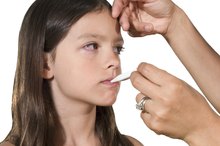The Signs a Fever Has Broken in Infants
Fever is a normal reaction and is usually a positive sign that your body is fighting an infection. Fever means your child's body temperature is higher than normal. When fewer is breaking, the worst is usually over and your child's temperature is coming back down. Although, fever will improve your body's immune defenses, it can make your child feel uncomfortable, even when it is breaking. Know the symptoms of fever and when it is breaking and help ease the discomfort they cause to your child.
Fever
Your child's body temperature can vary with age, activity and time of day. According to the American Academy of Pediatrics, infants have higher temperatures than older children 1. A rectal reading of 100 degrees, or oral reading of 99 degrees Fahrenheit or less, is considered normal. Many things can cause fewer, including viral, bacterial and parasitic infections, cold and teething. Fever will usually break on its own, once your child's body has beat the cause of the fever.
- Your child's body temperature can vary with age, activity and time of day.
- Fever will usually break on its own, once your child's body has beat the cause of the fever.
Temperature
Is a Kid Still Sick When a Fever Breaks?
Learn More
Fever means your child's body temperature is higher than 100 degrees Fahrenheit. When fever is breaking, your child's body temperature begins to lower and return to the normal levels. This is a good sign and does not require any treatment. The best way to know if your child has a fever or if it is coming down is to take her temperature. Rectal temperature is considered to be the most accurate, but you can also use oral, ear or under arm temperature.
- Fever means your child's body temperature is higher than 100 degrees Fahrenheit.
- The best way to know if your child has a fever or if it is coming down is to take her temperature.
Body Symptoms
When fever is breaking, your child can have several symptoms, including sweating, feeling chilly, tired and weak. Help ease the symptoms by dressing your child lightly if she is sweating, or covering her with a blanket if she is feeling the opposite. Encourage your infant to rest and sleep until her body temperature is back to normal.
Behavior
How to Ease a Nighttime Cough in Children
Learn More
Your child's behavior can also be a sign of discomfort caused by fever. When fever is breaking, your infant can be irritable, fussy and/or cry. If your child is very uncomfortable and has a temperature over 102 degrees Fahrenheit, you can try ease the discomfort with fever medications, even when the fewer has broken and is starting to return to normal levels. Medications help bring the body temperature down by blocking the mechanisms of fever.
- Your child's behavior can also be a sign of discomfort caused by fever.
- If your child is very uncomfortable and has a temperature over 102 degrees Fahrenheit, you can try ease the discomfort with fever medications, even when the fewer has broken and is starting to return to normal levels.
Appetite
Fever can make your child lose her appetite. When fever is breaking, your child may start to feel hungry again. Give your infant milk, applesauce or other solid foods she is used to eating.
Considerations
Always call your pediatrician if your child has fever, even a mild one. Fever can be a result of a serious infection and your pediatrician will need to know about it. Also contact your pediatrician again if your infant's fever has not broken within three days or is getting worse.
Related Articles
References
- "Your Baby's First Year"; The American Academy of Pediatrics; 2nd edition; 2005
- MayoClinic.com; Fever Treatment: Quick Guide to Treating a Fever; January 2010
- Sullivan JE, Farrar HC. Fever and antipyretic use in children. Pediatrics. 2011;127(3):580-7. doi:10.1542/peds.2010-3852
- Chapman J, Arnold JK. Reye syndrome. In: StatPearls. Updated January 17, 2019.
- El-Radhi AS. Fever management: evidence vs current practice. World J Clin Pediatr. 2012;1(4):29-33. doi:10.5409/wjcp.v1.i4.29
Writer Bio
Maria Hoven is a health and fitness expert with over 10 years of expertise in medical research. She began writing professionally in 2004 and has written for several websites including Wound Care Centers and healthnews.org. Hoven is earning a Doctor of Philosophy in cell and molecular biology from the University of Nevada, Reno.









